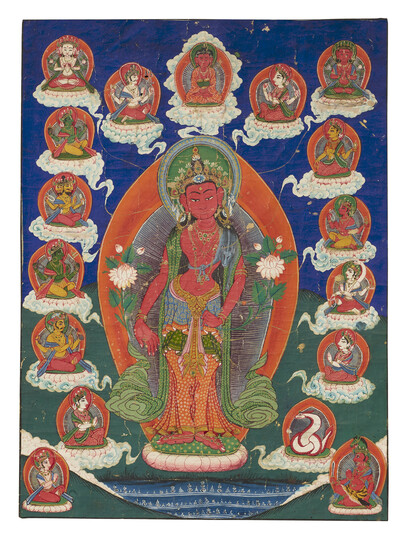
Item: Avalokiteshvara (Bodhisattva & Buddhist Deity) - Shristhikantha
| Origin Location | Nepal |
|---|---|
| Date Range | 1900 - 1959 |
| Lineages | Buddhist |
| Material | Ground Mineral Pigment on Cotton |
| Collection | Private |
Alternate Names: Lokeshvara Avalokita Lokanata Lokanatha Mahakarunika
Classification: Deity
Appearance: Peaceful
Gender: Male
This form of Avalokiteshvara is known in Kathmandu, Nepal, as Shristhikantha Lokeshvara. It is clear that the origins for this depiction are rooted in chapter 4 of the Karandavyuha Sutra written in prose dated to the 4th-5th century (possibly Kashmir).
In the Sutra there is a description of a number of Hindu gods arising from the body of Lokeshvara. However, there is no description of Lokeshvara having a red colour, or in a standing posture. It is most likely that the paintings shown below are also based on the much later and extended version of the Karandavyuha Sutra, in verse, popularized in Kathmandu in the first half of the 2nd millennium.
1.22 Bodhisattva Sarvanīvaraṇaviṣkambhin asked the Bhagavat, “What were the qualities of Bodhisattva Mahāsattva Avalokiteśvara that you heard the tathāgata describe?”
The Bhagavat said, “Āditya and Candra came from his eyes, Maheśvara came from his forehead, Brahmā came from his shoulders, Nārāyaṇa came from his heart, Devi Sarasvatī came from his canines, Vāyu came from his mouth, Dharaṇī came from his feet, and Varuṇa came from his stomach.
Toh 116. The Basket’s Display. ཟ་མ་ཏོག་བཀོད་པ། · za ma tog bkod pa. Kāraṇḍavyūha.
Collection: Christies New York Online, March, 2022 (Painting)
Buddhist Deity: Avalokita, Shristhikantha (Red, Standing)
Collection: Christies New York, September, 2021 (Painting)
